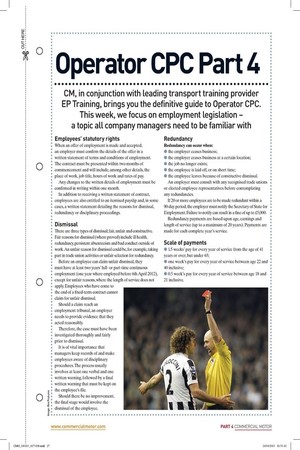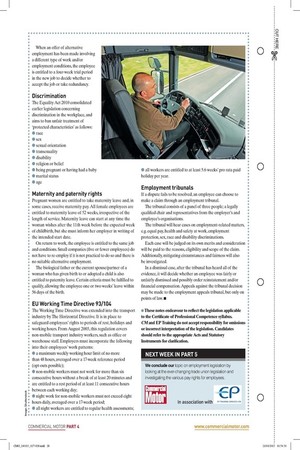erator CPC Part 4
Page 22

Page 23

If you've noticed an error in this article please click here to report it so we can fix it.
CM, in conjunction with leading transport training provider EP Training, brings you the definitive guide to Operator CPC. This week, we focus on employment legislation - a topic all company managers need to be familiar with Employees' statutory rights When an offer of employment is made and accepted, an employer must confirm the details of the offer in a written statement of terms and conditions of employment. The contract must be presented within two months of commencement and will include, among other details, the place of work, job title, hours of work and rates of pay.
Any changes to the written details of employment must be confirmed in writing within one month.
In addition to receiving a written statement of contract, employees are also entitled to an itemised payslip and, in some cases, a written statement detailing the reasons for dismissal, redundancy or disciplinary proceedings.
Dismissal There are three types of dismissal; fair, unfair and constructive. Fair reasons for dismissal (where proved) include ill health, redundancy, persistent absenteeism and bad conduct outside of work. An unfair reason for dismissal could be, for example, taking part in trade union activities or unfair selection for redundancy.
Before an employee can claim unfair dismissal, they must have at least two years' fullor part-time continuous employment (one year where employed before 6th April 2012), except for unfair reasons, where the length of service does not apply. Employees who have come to the end of a fixed-term contract cannot claim for unfair dismissal.
Should a claim reach an employment tribunal, an employer needs to provide evidence that they acted reasonably.
Therefore, the case must have been investigated thoroughly and fairly prior to dismissal.
It is of vital importance that managers keep records of and make employees aware of disciplinary procedures. The process usually involves at least one verbal and one written warning, followed by a final written warning that must be kept on the employee's file.
Should there be no improvement, the final stage would involve the dismissal of the employee.
Redundancy Redundancy can occur when: • the employer ceases business; • the employer ceases business at a certain location; • the job no longer exists; • the employee is laid off, or on short time; • the employee leaves because of constructive dismissal.
An employer must consult with any recognised trade unions or elected employee representatives before contemplating any redundancies.
If 20 or more employees are to be made redundant within a 90-day period, the employer must notify the Secretary of State for Employment. Failure to notify can result in a fine of up to £5,000.
Redundancy payments are based upon age, earnings and length of service (up to a maximum of 20 years). Payments are made for each complete year's service.
Scale of payments • 1.5 weeks' pay for every year of service from the age of 41 years or over, but under 65; • one week's pay for every year of service between age 22 and 40 inclusive; • 0.5 week's pay for every year of service between age 18 and 21 inclusive.
When an offer of alternative employment has been made involving a different type of work and/or employment conditions, the employee is entitled to a four-week trial period in the new job to decide whether to accept the job or take redundancy.
Discrimination The Equality Act 2010 consolidated earlier legislation concerning discrimination in the workplace, and aims to ban unfair treatment of 'protected characteristics' as follows: • race • sex • sexual orientation • transexuality • disability • religion or belief • being pregnant or having had a baby • marital status • age Maternity and paternity rights Pregnant women are entitled to take maternity leave and, in some cases, receive maternity pay. All female employees are entitled to maternity leave of 52 weeks, irrespective of the length of service. Maternity leave can start at any time the woman wishes after the 11th week before the expected week of childbirth, but she must inform her employer in writing of the intended start date.
On return to work, the employee is entitled to the same job and conditions. Small companies (five or fewer employees) do not have to re-employ if it is not practical to do so and there is no suitable alternative employment.
The biological father or the current spouse/partner of a woman who has given birth to or adopted a child is also entitled to paternity leave. Certain criteria must be fulfilled to qualify, allowing the employee one or two weeks' leave within 56 days of the birth.
EU Working Time Directive 93/104 The Working Time Directive was extended into the transport industry by The Horizontal Directive. It is in place to safeguard employees' rights to periods of rest, holidays and working hours. From August 2003, this regulation covers non-mobile transport industry workers, such as office or warehouse staff. Employers must incorporate the following into their employees' work patterns: • a maximum weekly working hour limit of no more than 48 hours, averaged over a 17-week reference period (opt-outs possible); • non-mobile workers must not work for more than six consecutive hours without a break of at least 20 minutes and are entitled to a rest period of at least 11 consecutive hours between each working day; • night work for non-mobile workers must not exceed eight hours daily, averaged over a 17-week period; • all night workers are entitled to regular health assessments; • all workers are entitled to at least 5.6 weeks' pro rata paid holiday per year.
Employment tribunals If a dispute fails to be resolved, an employee can choose to make a claim through an employment tribunal.
The tribunal consists of a panel of three people; a legally qualified chair and representatives from the employer's and employee's organisations.
The tribunal will hear cases on employment-related matters, e.g. equal pay, health and safety at work, employment protection, sex, race and disability discriminations.
Each case will be judged on its own merits and consideration will be paid to the reasons, eligibility and scope of the claim. Additionally, mitigating circumstances and fairness will also be investigated.
In a dismissal case, after the tribunal has heard all of the evidence, it will decide whether an employee was fairly or unfairly dismissed and possibly order reinstatement and/or financial compensation. Appeals against the tribunal decision may be made to the employment appeals tribunal, but only on points of law. • • These notes endeavour to reflect the legislation applicable to the Certificate of Professional Competence syllabus. CM and EP Training do not accept responsibility for omissions or incorrect interpretation of the legislation. Candidates should refer to the appropriate Acts and Statutory Instruments for clarification.










































